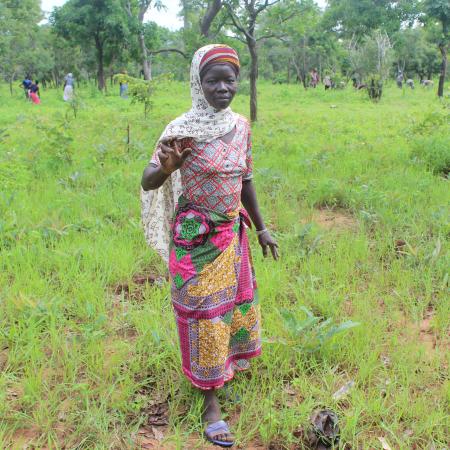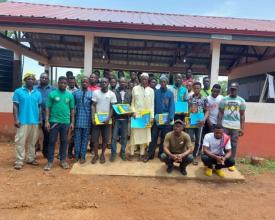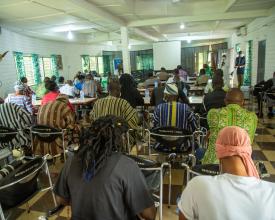
Restauración del paisaje forestal mediante una cadena de valor sostenible de la dendroenergía

El proyecto "Restauración del paisaje forestal a través de una cadena de valor sostenible de la dendroenergía" se lleva a cabo en la región de Bono East y Savannah de Ghana. Mediante la producción sostenible y el uso eficiente de madera energética, se están restaurando y preservando los bosques de regiones seleccionadas de Ghana, contribuyendo así a la aplicación de la política climática nacional y a la mejora de las condiciones marco para la gestión forestal sostenible y el suministro de energía en Ghana.
La dendroenergía en forma de carbón vegetal y leña es la principal fuente para cocinar en Ghana. Más de 14 millones de metros cúbicos de madera se utilizan anualmente para el consumo como carbón vegetal o leña. La dendroenergía es, por tanto, uno de los motores de la degradación de los bosques, especialmente en los focos de producción de carbón vegetal. Esta solución consiste en apoyar a las instituciones asociadas y a los pequeños agricultores en el establecimiento de una cadena de valor sostenible de la dendroenergía integrada en las medidas de restauración del paisaje forestal.
Contexto
Défis à relever
La biomasa representa el 39% del consumo energético de Ghana. La leña o el carbón vegetal siguen siendo el principal combustible para 4,53 millones de hogares en 2021 (Servicio Estadístico de Ghana, 2022) y la demanda de combustible de madera sigue aumentando debido al crecimiento de la población. Esta creciente demanda ha suscitado preocupación por el impacto en la cubierta arbórea y la seguridad del suministro en el futuro. La Política Energética Nacional (2010) afirma que "la explotación de biomasa con fines energéticos da lugar a la deforestación" (Ministerio de Energía, 2010) y el sector del carbón vegetal se identifica específicamente como uno de los "principales motores de la deforestación" (Ministerio de Energía, 2019).
La propiedad y los derechos de uso de las zonas forestales naturales son a menudo poco claros y la tala ilegal e incontrolada para la producción de carbón vegetal está amenazando especies arbóreas valiosas y raras. Además, las emisiones de humo durante la producción y el consumo de carbón vegetal pueden causar graves efectos sobre la salud.
Ubicación
Procesar
Resumen del proceso
Los cuatro componentes básicos constituyen los pasos de la aplicación en el uso eficiente y sostenible de la leña para ayudar a reducir las presiones sobre los bosques.
Bloques de construcción
Aumentar las fuentes de biomasa leñosa
El proyecto de Restauración del Paisaje Forestal estableció 3 viveros comunitarios en la zona del proyecto y crió 1 millón de plantones de árboles locales entre 2020 y 2022. Se rehabilitaron los bosques naturales degradados por la producción de carbón vegetal, la tala ilegal, el pastoreo de ganado, los incendios de matorrales, etc., y se establecieron 315 ha con especies arbóreas de crecimiento rápido para que sirvieran como fuente de madera para la producción de carbón vegetal. Los propietarios de tierras y de plantaciones recibieron formación sobre los servicios ecosistémicos de los bosques naturales, el seguimiento de los bosques y la biodiversidad, las medidas de rehabilitación y las prácticas agroforestales.
Las actividades se mantienen a largo plazo y se refuerza su función como sumideros de carbono mediante planes de gestión y sistemas de seguimiento para la rehabilitación de bosques naturales degradados y zonas agroforestales.
Factores facilitadores
La disponibilidad de tierras, unos derechos claros de uso de las mismas y el compromiso de la comunidad son fundamentales para el establecimiento y la gestión sostenible de la madera energética y los emplazamientos agroforestales. Especialmente en zonas muy degradadas con escasas fuentes de biomasa leñosa, las especies arbóreas de crecimiento rápido pueden proporcionar a corto plazo leña para la producción de carbón vegetal.
Lección aprendida
En zonas con un buen potencial de regeneración natural no suele ser necesario plantar árboles. Es más importante reducir riesgos como los incendios forestales incontrolados, que perjudican la regeneración inminente. Las especies arbóreas de crecimiento rápido seleccionadas deben adaptarse a las condiciones del lugar e integrarse en sistemas agroforestales o cinturones verdes contra incendios para reducir el riesgo de pérdidas por incendios forestales o pastoreo.
Gestión sostenible de los recursos forestales
La tala de árboles en bosques naturales para la producción de carbón vegetal y leña no está regulada ni controlada en Ghana. Esto conduce a la sobreexplotación y a una gestión forestal insostenible. La aplicación de un sistema de inventario y seguimiento basado en las necesidades de las comunidades es clave para lograr una gestión forestal sostenible.
Factores facilitadores
Se elaboraron planes comunitarios de gestión forestal que integran la gestión sostenible de los lugares de restauración del proyecto y de plantación de madera energética, pero también la protección de zonas seleccionadas como, por ejemplo, las zonas de amortiguación de los ríos y la gestión general de los recursos forestales. Los incendios forestales incontrolados destruyen la regeneración natural y las plántulas plantadas. Por ello, también se integró en los planes un sistema de gestión de incendios forestales, apoyado por la formación de voluntarios en patrulla y extinción de incendios incontrolados.
Lección aprendida
Las comunidades y los productores de carbón vegetal deben estar bien integrados en el desarrollo de un sistema de seguimiento y gestión forestal. Además, deben contar con el apoyo de las autoridades locales para determinar, por ejemplo, el volumen sostenible de madera que puede talarse anualmente y para seleccionar las zonas y las especies de árboles que deben protegerse de la tala. Para que la gestión de los incendios forestales funcione es fundamental que los agricultores y ganaderos sean conscientes de los riesgos y daños que pueden causar los incendios incontrolados y de cómo pueden controlarlos.
Reducir la demanda de dendroenergía
En las comunidades del proyecto se han introducido dos enfoques para el uso eficiente de la dendroenergía. Se han distribuido 5.000 cocinas de carbón eficientes y 5 hornos de carbón móviles (horno de caja Adam) para mejorar la producción y el consumo de carbón. Se ha demostrado que el horno de caja tiene una eficiencia del 30% en comparación con los hornos tradicionales y es más fácil y barato de construir que los hornos metálicos convencionales. Las comunidades locales han recibido formación sobre el funcionamiento del horno de caja metálica. Además, se ha impartido formación a formadores para introducir otras formas más eficientes de producción de carbón vegetal, como por ejemplo la técnica Casamance.
Factores facilitadores
La mayoría de los productores de carbón vegetal de Ghana utilizan la técnica de los montículos de tierra para producir carbón vegetal con una eficiencia baja, en su mayoría inferior al 20%. Con técnicas mejoradas, la eficiencia puede aumentar hasta un 35%, lo que puede reducir a la mitad la demanda de madera para producir la misma cantidad de carbón vegetal. Además, la carbonización se hace en menos días y necesita menos mano de obra.
Lección aprendida
Los productores de carbón vegetal acogieron con satisfacción el horno de caja debido a la carbonización más rápida, la mayor eficiencia y el menor trabajo (por ejemplo, no hay que cavar la tierra). Dado que los productores de carbón vegetal trabajan principalmente de forma individual, es importante crear grupos de productores para que el horno pueda utilizarse de forma continuada. Como la producción de carbón vegetal suele tener lugar donde se talan los árboles, también es importante organizar un sistema de transporte para el horno de caja o utilizarlo junto a las plantaciones de madera energética establecidas, donde se dispone de mayores cantidades de biomasa.
Apoyar las estrategias gubernamentales para una cadena de valor sostenible de la dendroenergía
Para pasar de la producción insostenible a la sostenible, el carbón vegetal y los combustibles alternativos (por ejemplo, briquetas de residuos agrícolas) deben ser competitivos en el mercado. Esto sólo puede lograrse con apoyo gubernamental, regulando la producción de carbón vegetal y permitiendo precios competitivos. Esto incluye la creación de un sector formal y un sistema de gestión forestal sostenible (véase el building block 2).
Factores facilitadores
El gobierno de Ghana ve la necesidad de reducir la degradación forestal a través de la producción de carbón vegetal y ha establecido ambiciosas medidas políticas en las NDC actualizadas para lograr una producción de carbón vegetal eficiente y sostenible. El gobierno también está trabajando en una regulación nacional para la producción de carbón vegetal y ha incluido otras medidas como la promoción de cocinas eficientes y el establecimiento de arboledas en diferentes estrategias.
Lección aprendida
En el desarrollo de normativas y estrategias para la producción sostenible de carbón vegetal, es importante incluir a las distintas partes interesadas, especialmente las comunidades locales y los productores de carbón vegetal. Necesitan ver los beneficios de un sector formalizado y de un sistema de regulación y necesitan apoyo para adaptarse a él. Además, es importante desarrollar fuentes de ingresos alternativas para lograr la promoción de combustibles alternativos y la reducción de la producción de carbón vegetal.
Impactos
- 315 ha de tierras degradadas han sido reforestadas con especies arbóreas de crecimiento rápido y se utilizarán de forma sostenible para el suministro de madera energética.
- 480 ha de bosques naturales degradados están siendo objeto de medidas de restauración como la RNFM y la plantación de enriquecimiento, y se han elaborado planes de gestión sostenible.
- Se han establecido 264 hectáreas de sistemas agroforestales con anacardos, mangos, moringas, dawadawa y otras especies locales con 150 pequeños agricultores.
- Más de 3.000 personas (80% mujeres) de las comunidades del proyecto han participado en la cría, plantación y mantenimiento de más de un millón de plantones.
- 170 personas de la comunidad han sido seleccionadas, formadas y equipadas como voluntarios para la prevención, extinción y extinción de incendios forestales.
- Se han instalado carteles con el índice de peligro de incendios en las 12 comunidades del proyecto, que se actualizan diariamente gracias a las tres estaciones meteorológicas instaladas.
- Se han distribuido 5.000 cocinas mejoradas en las comunidades del proyecto para reducir el consumo de carbón vegetal.
- Se han construido y distribuido 5 hornos metálicos (Adam-Box) para apoyar la carbonización eficiente del carbón vegetal.
- Mediante el apoyo al Ministerio de Energía, se integró en las NDC actualizadas de Ghana una nueva acción política sobre la promoción de la producción sostenible de carbón vegetal.
- Se han realizado estudios sobre la cadena de valor del carbón vegetal en Senegal y Burkina Faso y se han elaborado recomendaciones para una cadena de valor sostenible de la dendroenergía en la región de la CEDEAO.
Beneficiarios
- Funcionarios gubernamentales
- Comunidades seleccionadas para el proyecto
- Terratenientes
- Líderes locales
- Productores de carbón vegetal
Objetivos de Desarrollo Sostenible
Historia

Karima es una mujer de 42 años con 5 hijos que vive en Soalepe, una pequeña ciudad de la región de Savannah, en Ghana. Quema y vende carbón vegetal como negocio familiar para ganarse la vida y ha sido productora de carbón vegetal desde su infancia. Como consecuencia de la tala constante de árboles en los alrededores para la producción de carbón vegetal, ahora tiene que recorrer largas distancias a pie en busca de madera para la producción de carbón vegetal. Esto ha incrementado su tiempo y los costes de transporte del carbón desde el bosque hasta su casa.
La introducción del proyecto de Restauración del Paisaje Forestal en su comunidad ha tenido un impacto positivo en su negocio de carbón. Ha tenido la oportunidad de plantar árboles de crecimiento rápido en las tierras degradadas de los alrededores en forma de parcela forestal. En los próximos dos o tres años, no tendrá que recorrer largas distancias en busca de madera para su negocio de carbón, ya que podrá acceder directamente a las parcelas. El proyecto FLR también le presentó el eficaz horno ADAM Box para la carbonización del carbón vegetal. En combinación con la parcela, ahora puede cosechar y producir carbón vegetal en un solo lugar y, al utilizar el horno de caja, no necesita cortar hierba y cavar tierra sobre la madera empaquetada antes de quemarla, que es la forma tradicional de producir carbón vegetal. Con todo el esfuerzo que supone quemar el carbón de la forma tradicional, tarda más de una semana en terminar una carbonización completa con una eficiencia muy baja. Con el horno de caja, puede producir en 3 días carbón de alta calidad listo para el mercado, y más eficiente en comparación con la forma tradicional de carbonizar el carbón.
Karina es ahora una defensora de la restauración del paisaje forestal e influye en otros productores de carbón vegetal para que participen en la restauración de las tierras degradadas de los alrededores plantando más árboles para la sostenibilidad de su negocio de carbón vegetal.
















